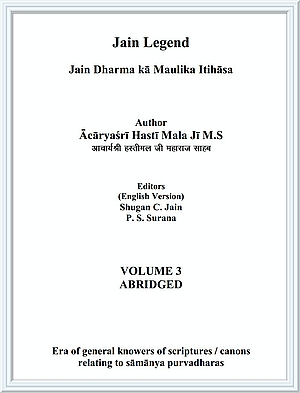There had been a number of Influential ācāryas who were composers of great holy texts and who by composing grand and voluminous religious texts have contributed immensely to the cause of vast corpus of Jain literature. The name of Ācārya Jina Sena (Punnāṭa congregation) stands out in the foremost row amongst them. A famous composition by the name 'Harivaṃśapurāṇa' by Ācārya Jina Sena is available now. However it is an extremely important text as Digambara tradition considers it like a scripture ever since it was composed.
Ācārya Jina Sena in its citation had mentioned its composition in Śaka 705 or Vikram 840.
Ācārya Jina Sena in this text has primarily written about the highly glamorous Yādava lineage of Harivaṃśa but more particularly about the lives of the main icons of Yādava lineage, the 22nd Tīrthaṃkara Ariṣṭanemi or Neminātha and ninth Nārāyaṇa (Vāsudeva) Śrīkṛṣṇa. Actually the composer of 'Harivaṃśapurāṇa' has even included the entire epic Mahābhārata also in it.
The most important contribution of 'Harivaṃśapurāṇa' is that it has given the chronological names of all ācāryas of the unified Śramaṇa congregation from the time of Lord Mahāvīra till his time (i.e. Ācārya Jina Sena of Punnāṭa congregation). An important disclosure in this chronology is the mention of Ācārya Śivagupta, who because of his exemplary virtues was decorated with the title Arhadbali. This fact can assist the scholars in further and advanced research to establish the time and reasons for the separation of the combined Śramaṇa congregation and origin of Digambara congregation therein.
Actually this jewel like text 'Harivaṃśapurāṇa' by Ācārya Jina Sena is of extreme importance for those interested in the history and antiquity of Jainism.
That Punnāṭa congregation was the popular congregation of Karnataka in south India can be said on firm basis as from an ancient inscription of approximately Śaka 522 in the Pārśvanātha temple of the vasati in Śravaṇabelagolā states that Ācārya Bhadra Bahu-II with his disciples went to a place called Kaṭavapra in Karnataka Pradeśa. At that time the capital of Punnāṭa Pradeśa was called Kittūra and hence Punnāṭa was also called Kittūra or Kaṭavapra. Ācārya Jina Sena might have on a routine wandering gone to Giranāra for pilgrimage; and composed Harivaṃśapurāṇa' there itself. You were a contemporary of the composer of Ādipurāṇa and Jayadhavalā by Paṃcastūpānvayī Ācārya Jina Sena.?
Kṛṣṇarṣi gaccha
Kṛṣṇarṣi gaccha came into existence as a branch of Thāraprada gaccha (Baṭeśwara). In the first half of Vikram ninth century; the great friar? (Tapasvī) Kṛṣṇarṣi of Hārila gaccha started a separate gaccha after his own name as Kṛṣṇarṣi gaccha
The founder of this gaccha, Kṛṣṇarṣi was a co-disciple-brother of Udyotana (author of 'Kuvalayamālā') and disciple of Yakṣamahattara who was disciple of sixth ācārya Tattvācārya of Hārila gaccha.
Ācārya Kṛṣṇarṣi was a great friar. It is said that the sequence of his penance used to grow continuously. He used to accept food only thirty four times in a year. Besides 34 days, he used to spend the remaining ten months and 26 days in a year performing severe penance. Performing such penance, he acquired several extraordinary powers. According to the records of lineages, it is said that he converted an elder of Nāgaura, Nārāyaṇa to Jainism and established a new lineage of Oswāls known as Baraḍiyā. Nārāyaṇa, on the inducements by Kṛṣṇarṣi built a Jain temple in Nāgaura and had the idol of Lord Mahāvīra installed there. Kṛṣṇarṣi also created a management council for administration and upkeep of this temple by inducting 72 respected elders of the town to it.
Kṛṣṇarṣi also converted many non-Jains to be devoted Jain householders. He organized a number of pilgrimages to the places associated with auspicious events of the lives of tīrthaṃkaras. With his encouragements, several Jain temples were built and in this way he served immensely the cause of Jainism.
 Acharya Hasti Mala
Acharya Hasti Mala
